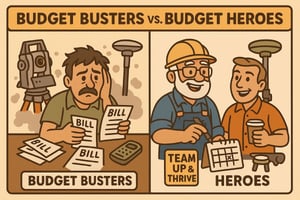Introduction In an era where technological advancements unfold at an unprecedented pace, businesses...
Risk Should Not be a Four-Letter Word
Introduction
In our last article we explored the adaptive role an owner must play in their land surveying firm. Anyone who has worked for someone else has likely experienced moments where their boss’s decisions seemed questionable, and it’s easy to criticize them after the fact, but there may be a valid reason for these decisions: Risk and Reward. In this article, we will delve into the concept of risk, often misunderstood, and compare two extremes to illustrate its importance in decision-making.

Completely Risk Averse
This person is afraid to take any sort of risk and therefore content with the status quo and the safety they have built around them. For them there is no growth, change, or anything that could cause them discomfort, and they like it this way. This person is happy to work a job where they are micro-managed because it means they have to make zero decisions and never put themselves out there for criticism: it’s just too risky.
Completely Risk Seeking
In contrast, this person is not afraid of risk and seeks it out, no matter how little of a reward. Risk seekers see the huge rewards that can come from their choices, but often revel in the risk as much as the reward. This person usually holds a higher position than their risk averse counterpart because they are ok with the thought of a risk not being worth the reward, and therefore are more willing to put themselves out there and take chances that lead to growth.
Finding Your Place
Notice I didn’t discuss right or wrong with either example. Obviously you shouldn’t strive for the extremes of either, but where you fall on the spectrum of risk aversion is where you are comfortable. There is nothing wrong with disliking risk or seeking it out. Our risk tolerance can even change over time, which is best illustrated with a properly managed retirement portfolio. The younger you are, the higher the percentage of stocks (more risk) in your portfolio. This number decreases the closer to retirement in order to ensure more stability and lower long-term risk. Higher risk early on can boost your portfolio through greater gains, but it can also mean it’s easier to lose. So how does this have anything to do with owning a land surveying business? A lot, actually.
As a business owner, you have to be willing to take risks. Imagine if you inherited a land surveying firm but were very risk averse. You’d remain stagnant and revenue would slowly decline as other firms become more willing to take risks and grow. Now, if you’re one of those other firms with a higher risk-seeking mentality, you are more likely to see growth and an increase in revenue. While it’s easy to discuss the idea behind risk, the reality is you are probably faced with many of these decisions on a regular basis. Finding a balance between these extremes can help you navigate the challenges and opportunities in your business more effectively.
It's important to look at ourselves and evaluate our level of risk aversion. There are many different ways to look at it, but the simplest method is below:
- Comfort: How comfortable are you with risk?
- Balance: At what point do you feel the risk isn’t worth the reward?
- Minimize: How are you able to make more informed decisions, diversify options, and benchmark decisions for monitoring?
- Approach: Risk avoidance is probably not the best strategy for business owners, so look for a balance of risk aversion vs. risk seeking.
Examples of risks
- Field work scheduled during July in an arid area when the temperatures are forecast to be around 100 degrees.
- A customer wants another boundary survey done because their combative neighbor has moved the survey stakes the last crew left.
- You need to purchase a new work truck but revenues have been in a slow decline and you’re afraid you won’t be able to afford payments this time next year.
- You want to run a radio advertisement campaign but the ads you ran online didn’t produce the desired outcome, and radio is more expensive.
These are all very real risks that one could face. The first two could potentially put employees in harm’s way (among other things, but your employees should be of the utmost importance), while the others could have long-term operations implications if they don’t play out right. The question ultimately becomes: How do I know what the correct decision is? Well, you don’t, however there are ways in which you can mitigate risk and make decisions based on your comfort level.
A simple method we can use to assess and manage risks is as follows:
- Identify the risk: What potential issues are there and what situations could it lead to?
- Evaluate the impact: To what degree can these risks impact your business as a whole, and what is the opportunity cost (what do you give up by taking, or not taking, this risk)?
- Develop a risk strategy: Create a game plan to minimize the impacts through mitigation and avoidance.
- Monitor the risk: Continue to monitor and be ready to adjust if necessary.
We can apply this method to the examples listed above. For example, we’ll look at field work in July:
- Identify: The primary risk is heatstroke and the health of the field crew.
- Evaluate: An employee’s health is of the utmost importance and if something were to happen to them, the business would also take a hit and their reputation would decrease, as well as health costs and insurance possibly increasing.
- Develop: Employees will begin early in the morning and bring proper protective clothing and equipment, as well as carry a minimum of one gallon of water each. Additionally, allow for and encourage an increased frequency of breaks. Field crews might want to finish early, but stress that they must be cautious in the heat.
- Monitor: Keep in contact with the crew more than normal. This may seem like micro-management, but the safety of your employees is worth it.

Conclusion
Many times, we manage risk in this way internally, and there’s no need to formally strategize a risk management plan. While this is acceptable in many situations, it’s important to remember these steps in riskier situations that are somewhat more complicated, such as the advertising campaign mentioned above.
The way we manage risk varies from person to person, business to business, and even depending on the situation. Whether you tend to be more risk averse or embrace a more risk-seeking approach, you must make decisions based on your level of comfort. Using our simple method outlined above to carefully evaluate and clearly understand the potential impact of these risks is critical. This structured approach helps to minimize unwanted outcomes while allowing for informed decisions that align with your business and business strategy. Business owners understand that a certain level of risk tolerance is necessary. Those who embrace a balanced perspective on the risk-aversion spectrum are more likely to succeed while staying true to their values.




